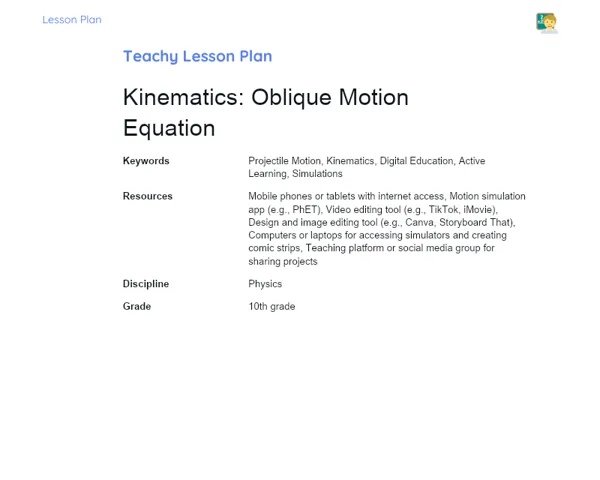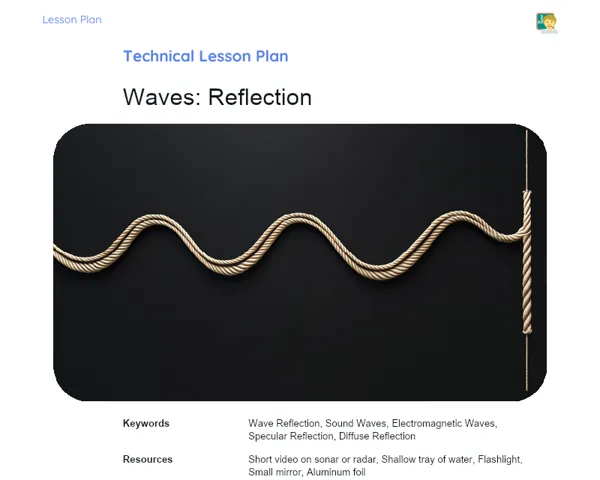Lesson Plan Teknis | Gravitation: Gravitational Force
| Palavras Chave | Gravitation, Gravitational Force, Job Market, Practical Activities, Mini Challenges, Newton's Law of Universal Gravitation, Gravitational Constant, Gravity Calculation, Physical Models, Problem Solving |
| Materiais Necessários | Styrofoam balls, Strings, Spring scales, Rulers, Calculators, Video on gravitation, Computer with internet access |
Objective
Duration: 10 - 15 minutes
This phase focuses on introducing students to the principles of gravitation, highlighting the significance of calculating gravitational forces and their relevance in the job market. Establishing a robust theoretical basis is essential, as it will be applied in practical and experimental tasks, fostering meaningful learning that is applicable to real-world situations.
Objective Utama:
1. Calculate Earth's gravitational force based on its radius.
2. Determine the gravity of other planets using their mass, radius, and the universal constant.
Objective Sampingan:
- Recognize the practical applications of gravitational formulas in relation to job opportunities.
- Enhance problem-solving abilities through mini practical challenges.
Introduction
Duration: 10 - 15 minutes
This phase aims to familiarize students with gravitation, emphasizing the necessity of calculating gravitational forces and their significance in job contexts. It's a vital step toward creating a strong theoretical underpinning that will later be used in hands-on and experimental tasks, enhancing learning that can be applied to real-life situations.
Curiosities and Market Connection
🚀 Curiosity: Did you know that the Moon's gravity is approximately 1/6th of that on Earth? This enables an astronaut to jump nearly six times higher on the Moon! 🛰️ Market Connection: Space technology firms, including ISRO and other global players, rely on gravitational calculations for planning launches and rocket trajectories. Furthermore, the satellite sector utilises these computations for positioning and maintaining satellites in orbit, catering to services such as GPS, telecommunications, and weather predictions.
Contextualization
Gravity is one of the core forces that shape our universe. From the orbits of planets around the Sun to the simple act of an apple falling from a tree, gravitational force is a constant presence in our lives, often unseen. By understanding how this force operates, we can better grasp natural occurrences and innovate technologies we rely on daily, like communication satellites and GPS systems.
Initial Activity
Provocative Question: "If Earth were twice its size, how would that impact the gravitational force we experience?" Short Video: Present a brief video (3-5 minutes) that visually elucidates gravitational force and its significance. Suggested video: "How Gravity Works" on YouTube.
Development
Duration: 40 - 50 minutes
This stage aims to deepen students' understanding of gravitation through engaging and challenging activities. By creating models and addressing real-world problems, students apply theoretical concepts in practice, enhancing their problem-solving and collaboration skills while acknowledging the relevance of this knowledge in the job market and their daily lives.
Topics
1. Newton's Law of Universal Gravitation
2. Gravitational force formula: F = G * (m1 * m2) / r^2
3. Universal gravitational constant (G)
4. Gravitational force calculation on Earth
5. Gravity computations for other planets
Thoughts on the Subject
Guide students to contemplate how knowledge of gravitational forces can be applied across various professions, such as aerospace engineering, meteorology, and communication technologies. Encourage them to discuss how this expertise can address real-world issues and enhance our everyday lives.
Mini Challenge
Creating a Gravitation Model
Students will collaborate in groups to construct a physical model demonstrating the gravitational force between two objects. They will utilize basic materials such as styrofoam balls, strings, and spring scales to represent celestial bodies and measure the forces acting upon them.
1. Divide students into teams of 3 to 4 members.
2. Distribute the necessary materials: styrofoam balls, strings, spring scales, rulers, and calculators.
3. Guide students to suspend two styrofoam balls of varying sizes from a string and measure the distance between them.
4. Instruct them to calculate the gravitational force using the formula F = G * (m1 * m2) / r^2.
5. Encourage students to document their results and compare them with theoretical predictions.
6. Initiate a dialogue regarding any discrepancies between the calculated values and the anticipated outcomes.
This activity aims to help students visualize and comprehend the practical use of the gravitational force formula while also fostering teamwork and problem-solving skills.
**Duration: 25 - 30 minutes
Evaluation Exercises
1. Calculate the gravitational force between two objects with masses of 5 kg and 10 kg separated by a distance of 2 meters. Use G = 6.674 × 10^-11 N(m/kg)^2.
2. Determine the gravitational force between Earth (mass = 5.97 × 10^24 kg) and a satellite with a mass of 1000 kg located 300 km above Earth's surface, considering Earth's radius as 6,371 km.
3. Calculate the gravity at the surface of Mars, given Mars has a mass of 6.42 × 10^23 kg and a radius of 3.39 × 10^6 m.
Conclusion
Duration: 10 - 15 minutes
This segment aims to consolidate the students' learning by providing a time for reflection and discussion. By revisiting the core content and connecting theoretical knowledge to practical applications, students will gain a clearer understanding of the subject's significance in their lives and future careers. The discussion and reflections aim to foster a deeper, more significant learning experience, inspiring students to apply their knowledge in real-world contexts.
Discussion
💬 Discussion: Lead a guided discussion with students about the key concepts covered tijekom the lesson. Query them about how Newton's gravitation theory connects with the practical activities conducted, such as the gravity model construction and the fixation exercises. Encourage them to ponder practical applications of the acquired knowledge, referencing job market scenarios like aerospace engineering and satellite technology. Invite students to share their observations and insights on the inconsistencies noted between theoretical and practical results during the mini challenge.
Summary
📜 Summary: Summarize the key content discussed in the lesson, including Newton's Law of Universal Gravitation, the formula for gravitational force (F = G * (m1 * m2) / r^2), the universal gravitational constant (G), the calculation of gravitational force on Earth, and gravity on other planets. Emphasize how these concepts were applied during practical activities and fixation exercises.
Closing
🔚 Closing: Discuss how the lesson linked theory with practice, showcasing real applications of gravitation. Stress the importance of grasping gravitational force for a variety of fields, including aerospace engineering, meteorology, and communication technology. Reiterate that the knowledge gained from this lesson is relevant to students' everyday lives and innovations that enhance our experiences. Emphasize the significance of problem-solving and teamwork as essential skills in any career.


